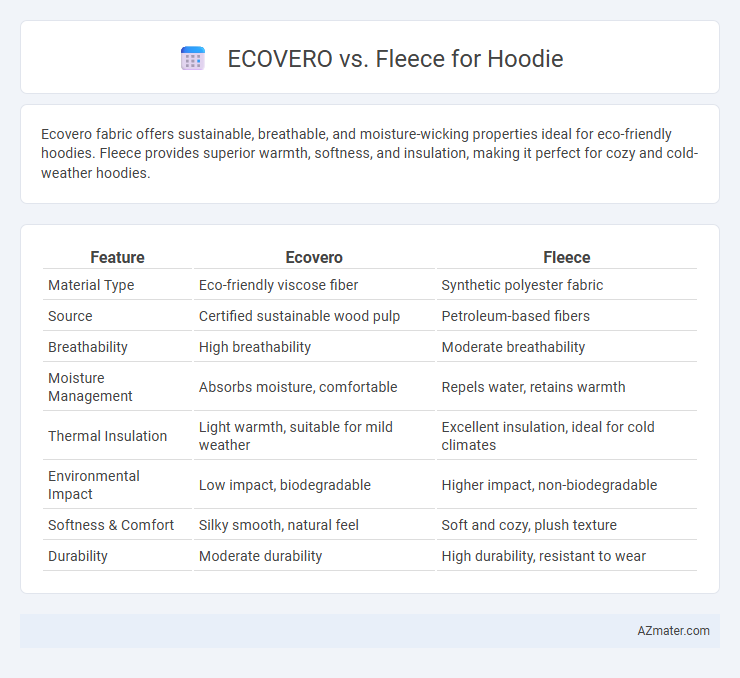Ecovero fabric offers sustainable, breathable, and moisture-wicking properties ideal for eco-friendly hoodies. Fleece provides superior warmth, softness, and insulation, making it perfect for cozy and cold-weather hoodies.
Table of Comparison
| Feature | Ecovero | Fleece |
|---|---|---|
| Material Type | Eco-friendly viscose fiber | Synthetic polyester fabric |
| Source | Certified sustainable wood pulp | Petroleum-based fibers |
| Breathability | High breathability | Moderate breathability |
| Moisture Management | Absorbs moisture, comfortable | Repels water, retains warmth |
| Thermal Insulation | Light warmth, suitable for mild weather | Excellent insulation, ideal for cold climates |
| Environmental Impact | Low impact, biodegradable | Higher impact, non-biodegradable |
| Softness & Comfort | Silky smooth, natural feel | Soft and cozy, plush texture |
| Durability | Moderate durability | High durability, resistant to wear |
Introduction to Ecovero and Fleece Fabrics
Ecovero fabric is an eco-friendly material made from certified sustainable viscose derived from responsibly managed forests, offering breathability and a soft feel ideal for hoodie production. Fleece fabric, typically crafted from polyester, provides excellent insulation, moisture-wicking properties, and lightweight warmth, making it a popular choice for cozy sweaters and hoodies. While Ecovero emphasizes sustainability and biodegradability, fleece focuses on thermal comfort and durability, catering to different consumer preferences.
Key Differences Between Ecovero and Fleece
Ecovero is a sustainable viscose fiber made from certified renewable wood sources that offers breathability and a soft, lightweight feel, making it eco-friendly and biodegradable. Fleece is a synthetic fabric, typically polyester-based, known for its insulation, warmth retention, and lightweight durability, but it is less environmentally sustainable and can contribute to microplastic pollution. The key difference lies in Ecovero's sustainable production and natural origin versus fleece's synthetic composition and superior thermal insulation properties.
Environmental Impact: Ecovero vs Fleece
Ecovero fabric, derived from sustainably sourced wood pulp, features a lower carbon footprint and reduced water consumption compared to traditional fleece, which is typically made from petroleum-based polyester. The biodegradable nature of Ecovero contributes to less environmental pollution, while fleece contributes to microplastic pollution in waterways due to synthetic fibers. Choosing Ecovero for hoodies significantly decreases environmental impact by promoting renewable resources and minimizing chemical use.
Comfort and Wearability Comparison
Ecovero fabric, made from sustainable viscose, offers exceptional breathability and softness, making it ideal for hoodies that demand both comfort and eco-friendliness. Fleece, known for its plush texture and superior warmth, excels in wearability during colder conditions by providing excellent insulation and moisture-wicking properties. The choice between Ecovero and fleece hinges on whether lightweight breathability or cozy warmth is prioritized for everyday hoodie wear.
Durability and Longevity of Each Fabric
Ecovero fabric, derived from sustainable wood pulp, offers moderate durability with a smooth texture ideal for eco-friendly hoodies, but it may show wear faster under heavy use. Fleece, typically made from polyester or blends, excels in durability and longevity, resisting pilling and maintaining softness over extended periods of wear and washing. For hoodies prioritizing long-lasting performance and robust durability, fleece remains the superior fabric choice compared to Ecovero.
Breathability and Moisture Management
Ecovero fibers, derived from sustainable wood sources, offer superior breathability compared to traditional fleece, making them ideal for moisture management in hoodies. Fleece, typically made from polyester, provides excellent insulation but can trap heat and moisture, potentially causing discomfort during intense activities. Hoodies crafted with Ecovero blend fabrics enhance airflow and wick moisture away from the skin, maintaining dryness and comfort in varied climates.
Style and Aesthetic Appeal for Hoodies
Ecovero fabric, made from sustainable viscose, offers a smooth, lightweight texture that drapes elegantly on hoodies, enhancing a sleek and polished look ideal for modern, eco-conscious fashion. Fleece provides a cozy, plush feel with a textured surface, contributing to a casual, sporty aesthetic perfect for warmth and comfort in hoodies. Style choice depends on desired appeal: Ecovero suits minimalist, refined designs, while fleece complements relaxed, athleisure-inspired hoodies.
Maintenance and Care Instructions
Ecovero hoodies require gentle washing with mild detergents at low temperatures to maintain their sustainable viscose fibers and reduce environmental impact. Fleece hoodies demand regular washing to prevent pilling, ideally using cold water and avoiding fabric softeners to preserve softness and insulation properties. Both materials benefit from air drying to extend garment lifespan and maintain fabric integrity.
Cost and Accessibility of Ecovero vs Fleece Hoodies
Ecovero hoodies generally come at a higher price point compared to fleece due to their sustainable production process and eco-friendly materials derived from certified renewable wood sources. Despite the higher cost, Ecovero is increasingly accessible in specialty eco-conscious brands and online retailers that focus on sustainable fashion. Fleece hoodies remain widely available and affordable through mass-market retailers, making them a more budget-friendly option for everyday use.
Which Fabric Is Better for Sustainable Fashion?
Ecovero, a biodegradable fabric made from sustainably sourced wood pulp using a closed-loop production process, offers superior eco-friendliness compared to traditional fleece, which is often derived from non-renewable petroleum-based polyester. Ecovero's lower water consumption and reduced emissions make it a better choice for sustainable fashion, while fleece typically contributes to microplastic pollution and higher carbon footprints. For hoodies, selecting Ecovero supports environmentally conscious manufacturing and biodegradability, aligning with green fashion principles more effectively than fleece.

Infographic: Ecovero vs Fleece for Hoodie
 azmater.com
azmater.com